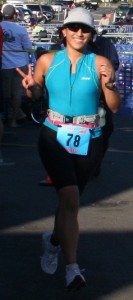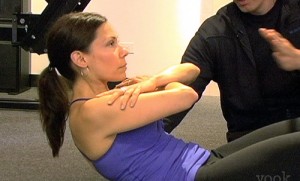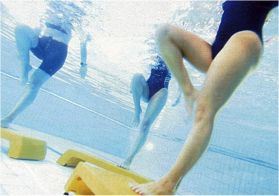by Michelle Sutton-Kerchner
Pain is inevitable. From minor cuts to debilitating injuries, hurting and healing is a natural cycle of living. How we cope is very individualized. It is possible to increase your tolerance …
Some of us are simply born with a higher tolerance for pain. Our genetics is made of sterner stuff. Perhaps it’s possession of family origins that began with toiling for long, hot hours on a farm. That’ll prepare you! Or, the opposite: descending from a silver-spoon environment where gentle years to the physical self resulted in genes that produce a rested body, ready to face challenges.
New research, published in the journal Pain, indicates lifestyle can affect your ability to grin-and-bear-it. Those who exercise, specifically the athletic, tend to better handle hurts. These studies hint at new methods of drug-free pain management. And, they confirm yet one more perk of being a frequent exerciser.
The study’s author, Jonas Tesarz of University of Heidelberg explains the broader significance. “Studies in athletes offer the opportunity for an evaluation of the physical and psychological effects of regular activity on pain perception, which might foster the development of effective types of exercise for relief in pain patients.”

The findings suggest exercise could help those who suffer better cope with chronic pain.
Dealing with It
Pain originates in the nervous system. It can signal a problem or sickness, and often resolves once the issue is treated. Gentle stretching, rest, physical therapy, and rehabilitative exercises usually resolve common aches and pains. Ibuprofen and hot/cold compresses can help.
Chronic pain, defined as ongoing pain that can last for weeks or years, affects more than 86 million American adults. Sometimes the cause is unknown. Often, this population tries traditional therapeutic modalities to heal. With persistent pain, they may expand to acupuncture, chiropractic treatments, and perhaps psychotherapy for coping mechanisms.
What makes some stay in the game and others head to the couch? It could be the game itself.
Research performed in Germany examined 15 studies that compared pain tolerance and threshold between athletes and non-athletes. Athletes consistently reported higher pain tolerance, defined as the maximum amount of pain a person can withstand. Both groups had a similar pain threshold, defined as the point at which pain begins to be felt. Although both groups start to feel pain at the same point, athletes can endure it more.
Recent findings made a believer of researcher and editor-in-chief of Pain Allan Basbaum, chairperson of the anatomy department at the University of California, San Francisco. Previously skeptical of the connection, Basbaum now acknowledges the endorphins’ role in blunting pain. Endorphins are the feel-good hormone released during vigorous physical activity. They’re responsible for the “runner’s high” and exercise’s ability to help ease depression. The German studies proved strenuous exercise increases endorphin levels in the blood and brain.
Combined with a winning attitude to sweat it out, the fitness buff is often driven to persevere through pain. Basbaum notes, “Most athletes don’t ask themselves if it hurts. Rather, how much pain they can tolerate.” Admirable, yet a somewhat dangerous mentality. The same mentality may also lead to sports injury.

Some credit the high pain tolerance to skills learned in fitness training. Others believe it is learned over time and shared by a group who participates in similar activities. Of course, there is the endorphin factor and its analgesic effect.
Exercise as Your Pain-Reliever
Commit to fitness. And train like an athlete, even if you’re only the team members’ chauffer. That arthritic knee is your competition, and winning is a pain-free day. It is never safe to ignore pain. Yet, once its cause is diagnosed and a physician approves activity, learn a training program that keeps you in your game.
In ancient arts, there is much talk of becoming one with your pain. This sounds mysterious and slightly offputting. Embrace pain, acknowledge it. Don’t ignore it. But do not let it define you. You are not a “pain patient,” but an individual human being experiencing pain.
When pain takes hold of our emotional being, we hinder and delay the ability to heal. Disgust, anger, fear, and anxiety work against physical attempts to recover. Plow over these forces and face the challenge like an athlete. Although pain itself is not an option, recognize our reaction to it is. Don’t pile emotional anguish on top of the physical. Your body needs your positive support.

There are many modalities for sport specific training at the Center. Your workout can be modified each visit according to your needs. Take advantage of water workouts. Simple movements while submerged in the water’s buoyancy can provide relief. These allow you to build up tolerance to pain, even while suffering.
Pilates, the Pilates reformer, and yoga offers unique healing benefits that transcend the physical. They focus on the mental connection and deliver healing power. A personal trainer coaches to increase physical stamina and strength, while inspiring you to achieve a winning attitude despite that nagging ache. To train, and tolerate, like an athlete, you must learn to think like one.
Never push beyond pain. Rather, find a way to remain fit alongside daily pains. Learn ways to adjust your fitness program to accommodate– and heal– your weaknesses. A tweak to your Group Fitness routine or an adjustment on the Exercise Floor can have an impressive impact on perceived limitations.
Train yourself to play in spite of pain, whatever that “play” may entail. You are not that ache in your shoulder. You may need to call a time-out and occasionally blow the whistle on the whole game. But, it feels better than warming the bench. It looks better on your waistline, too!
Some members find themselves returning to fitness after rehabilitation from an injury or surgery. This setback landed them on the sidelines where their inner athlete atrophied and popped Aleve. They may graduate from physical therapy with a new limp and an extra 15 pounds. This determined bunch grabs life back. Not all at once, and sometimes by “stealing the bases.”
Like a talented athlete, train to quiet the surrounding noise– the joint’s popping, the hip’s murmuring threats, the negative self-talk. Forget becoming one with the pain. Become one with the workout. Focus. Execute. Repeat.
Your fans are waiting. Your spouse wants to travel with you. You children want to play with you. Your friends want you to pitch, catch, dance. Your boss, well, she just wants you to show up and work.
Your body wants to heal. Be tolerant.
Sources
“Athletes Have a Higher Tolerance for Pain Than Most, Says Study,” by Alexander Besant at www.globalpost.com.
“Pain Tolerance Higher in Athletes, May Help Unlock Clues to Fighting Pain,” by Salynn Boyles at www.webmd.com.
“Why to Exercise Today: Better Pain Tolerance,” at www.commonhealth.wbur.org.
Image Credits
Pull-up: www.flickr.com/photos/vooktv/3944213055/
Water workout: www.flickr.com/photos/24975064@N05/4840948510/
 Fitness & Wellness News Your Source for Fitness News, Wellness News, Health News, and Nutrition News!
Fitness & Wellness News Your Source for Fitness News, Wellness News, Health News, and Nutrition News!



